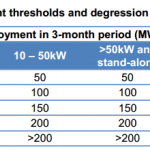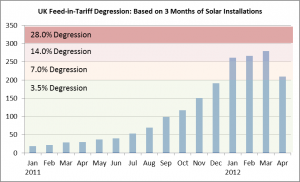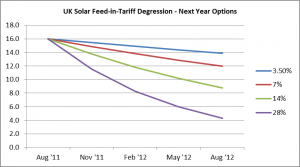 Now the new Feed-in-Tariffs have been announced to be valid from August, it’s time to look at some of the details of the government announcement. One of the key ideas is automatic degression (reduction) on a 3-month basis. The amount of degression would be based on the volume of installations in the previous 3-month period. However, this could mean further Feed-in-Tariff cuts of more than 50% in the coming year.
Now the new Feed-in-Tariffs have been announced to be valid from August, it’s time to look at some of the details of the government announcement. One of the key ideas is automatic degression (reduction) on a 3-month basis. The amount of degression would be based on the volume of installations in the previous 3-month period. However, this could mean further Feed-in-Tariff cuts of more than 50% in the coming year.
According to the government consultation document the solar Feed-in-Tariff degression will proceed every three months from November 2012 as follows (page 14 in document):

What this means is that if in any three month period installations will be below 200 MW (for systems of 0-10 kWp) then the Feed-in-Tariff will be reduced by 3.5%. However, if installations are higher than 300 MW the reduction will be a massive 28%. Looking at the actual 3-month total of installations based on actual monthly government FiT statistics we can create the following graph:
What this graph shows is that the risk of a 28% percent degression is actually quite real. And that in most months of this year a degression of 14% or 7% would have been reality rather than the much stated 3.5%. Furthermore, these statistics are only for systems between 1-4 kWp, and with the new tariffs it is more likely people install systems between 4-10 kWp (since the tariff is only 1.5pence lower). Also, once these strong cuts are announced there is a high risk that a boom-bust follows to rush before the cuts, meaning more installations are counted towards the next cuts – which therefore becomes a self-fulfilling prophesy. Theroretically we could hence end up with a Feed-in-Tariff of only 4 pence at the end of 2013, as the following graph shows:
Of course this is a strongly hypothetical scenario and not really realistic. However, the fact that the Feed-in-Tariff degression will double with every 50MW extra installed means the industry could be in for some surprises. Better monitor those statistics closely from August.

